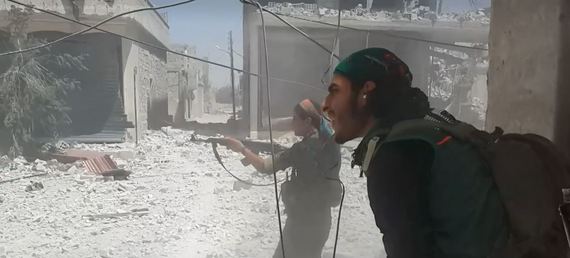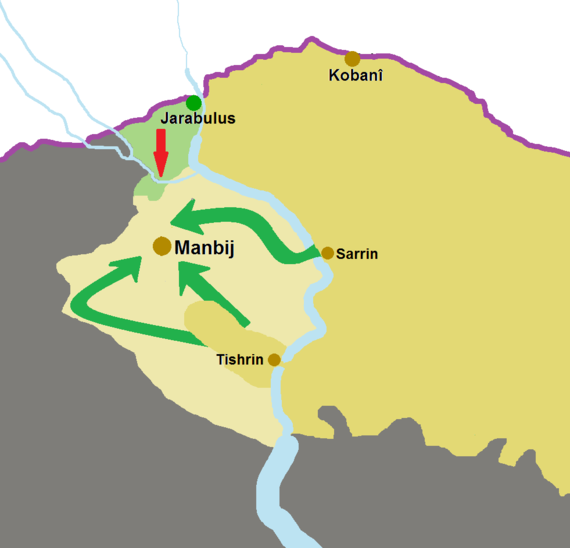Kurdish and Arab fighters of the Syrian Democratic Forces during the Battle of Manbij, July-August 2016
On August 24, 4:00 a.m. local time, Turkish military forces crossed over into Syria and began a drive to oust Islamic State (IS) militants from the Syrian town of Jarabulus. The town is the last remaining stronghold of IS along the Turkish-Syrian border and has been used as a smuggling route to bring jihadists into Syria, as well as smuggle out antiquities and oil.
The Turkish intervention, dubbed Operation Euphrates Shield, is being supported by U.S. and coalition air forces and possibly US Special Forces units, as well as approximately 1,500 to 2,000 fighters drawn largely from the Jabhat al-Shamiya, Sultan Murad, Turkmen Martyrs Battalion, Nour al-Din al-Zinki and Faylaq al-Sham units, from the Saudi and Turkish supported, Ahrar al-Sham. The total size of the Turkish force is unclear.
This is the second time that Turkish forces have intervened in Syria. In February 2015, a Turkish force crossed the border to evacuate Turkish troops guarding the tomb of Suleyman Shah, the grandfather of Osman I, the founder of the Ottoman Empire. The contents of the tomb were removed and taken to Turkey.
Both the Syrian government and the spokesman for the Kurdish led Syrian Democratic Forces (SDF) criticized the Turkish action. A Syrian government spokesman condemned the intervention as a "a blatant violation of Syrian sovereignty." A Syrian Kurdish spokesman called it "blatant aggression," and declared that Syria would become a "quagmire for Turkey."
The Turkish intervention adds a new element of uncertainty to a battlefield that in recent weeks has been growing even more chaotic and complex. Recently, Syrian and American jets found themselves in a close encounter, while below them the U.S. supported Syrian Democratic Forces (SDF) were engaged with units of the Syrian Army. Meanwhile in northern Syria, the SDF clashed with the Turkish backed, Free Syrian Army (FSA) while both were contesting control of Islamic State occupied Jarabulus in northern Aleppo province.
Turkey's action was prompted by the refusal of the Kurdish led SDF to retreat from newly taken Manbij and withdraw to positions on the east bank of the Euphrates. Ankara's insistence that the SDF not advance beyond the Euphrates has been an issue between Turkey and the United States, but it now appears that Washington has come around to supporting Ankara's position and is also insisting that the SDF withdraw. Over the last year the SDF has emerged as Washington's most effective proxy in the Syrian Civil War and there has been close cooperation between the SDF and U.S. air forces.
Faced with the choice of having to live with either the continuation of the Assad regime, at least in the short-term, or the prospect of a Kurdish state along its southern border, Ankara has opted for the former. It's likely that Turkish overtures to both Russia and Iran, and Ankara's new, publicly stated willingness to accept the continuation of Bashar al-Assad as a short-term transitional figure in a post-civil war Syria, was a quid pro quo for acceptance of the Turkish intervention.
For Ankara, the most important objective now is neither the defeat of the Islamic State nor the overthrow of the Assad regime, but to prevent the seizure of the portion of Aleppo province that lies between the Kurdish controlled Kobani and Afrin cantons by the SDF.
At the moment there are three major theaters of operation and one minor one in Syria. Two of these theaters are primarily engaged with the Islamic State, while the other two involve conflict between the various Syrian rebel groups and the Assad government.
North Aleppo Front prior to the Turkish intervention
These theaters are: the northern portion of the Aleppo Protectorate between Afrin and Kobani cantons; the city of Aleppo and Idib province; and the core Islamic State Euphrates corridor between Raqqa and Deir ez-Zour, and the minor southern front theater. The Turkish intervention will likely impact all three major theaters.
The conflict in the northern Aleppo theatre involves a twofold struggle, first to oust Islamic State from the region along the Turkish border, and secondly to determine whether they will be replaced by the American-backed, Kurdish led SDF or the Turkish supported FSA.
As of Wednesday morning, Turkish authorities announced that Islamic State militants were withdrawing from Jarabulus and that the town would soon be secured. That leaves al-Bab as the last major IS stronghold in the region.
Islamic State has lost control of most of the major roads that connect the border areas with Raqqa and the rest of Islamic State territory. It was still able, however, to use secondary roads around Jarabulus to smuggle in jihadists and to a lesser extent smuggle out antiquities and oil.
For the SDF, control of the region is critical to enable a linkup between Afrin, Kobani and Jazira cantons. This is the core area of the recently announced Syrian-Kurdish state of Rojava. For the FSA, the region is the main supply line from Turkey to Aleppo. The FSA can also supply Aleppo through Idib province, but this route is longer and there are more opportunities for Syrian and Russian air forces to interdict supply convoys.
The second major theater, the conflict in the city of Aleppo and in western Aleppo and Idib provinces, is primarily a contest between the FSA and various Syrian rebel groups against the Assad government. Islamic State, however, has mounted opportunistic attacks against both the Syrian government and rebel forces and is determined to prevent either side from dominating this area. This is the core area controlled by the Syrian rebels and the only region that has access to direct Turkish aid.
The total rebel strength is estimated at between 75,000 and 150,000. These groups include the FSA, Ahrar al-Sham, the Saudi backed coalition of various Islamist groups that collectively are second in strength to the FSA, Jabhat Fatah al-Sham, previously known as the al-Qaeda affiliated, al-Nusra Front, and a smaller Islamist alliance, also Saudi backed, Jaish al-Fatah. Ideological, religious and tribal divisions, however, hopelessly divide the rebels.
Against them are arrayed between 250,000 and 300,000 men consisting of Syrian Armed Forces, roughly half, various pro-Assad militias, a third, and with the balance made up of Lebanese Hezbollah and Iranian sponsored militias. Not all of these forces, however, are in theater.
The rebels have been supplied by Saudi Arabia and its Gulf allies and some of the groups within the larger rebel coalitions have received military equipment from the United States. Their biggest weakness, however, is that they lack consistent air support. Syrian forces, on the other hand, have the advantage of numerical superiority, better equipment and, most importantly, Russian and Syrian air support.
The third major theater is the core Islamic State territory in the Euphrates River valley from Raqqa to Deir ez-Zour. This is where the bulk of the Islamic State's population in Syria is located. This is the heart of IS. At its northern end is the Islamic State capital of Raqqa and at the southern end is Deir al Zour, at the junction of the transportation link between the two parts of Islamic State in Syria and Iraq.
Syrian civil war as of Augut 12, 2016
At the moment a force of SDF fighters have been slowly advancing toward Raqqa from the northeast. Syrian military forces have been advancing from the west toward Raqqa, while another force has been advancing from Palmyra, in the southwest, toward Deir al-Zour.
It's possible that the race to capture Raqqa might become a proxy contest between U.S. and Russian backed forces. The core IS territory is predominantly Sunni, however, and there are political issues with having a predominantly Kurdish force advancing into a historic Sunni area. Moreover, for the Kurds in the SDF, the primary objective remains the Northern Aleppo Theater. There is little interest in shedding Kurdish blood to liberate Sunni areas from IS control.
Syrian forces have been steadily advancing against both Raqqa and Deir al-Zour. Recent troop movements, and an escalation of Russian air attacks, suggest that Deir al-Zour is the immediate target of the Syrian advance. There are two Syrian brigades besieged by IS militants in the city. More importantly, the capture of Deir al-Zour would separate the last road link between the Islamic state in Iraq and Syria.
Eventually the war against Islamic State will come down to this core area. It's likely that IS will have been largely expelled from Mosul and the rest of Iraq by the time its core territory comes under direct attack. IS has had several years to prepare itself for the final onslaught. From here, its militants have nowhere else to go. In IS's apocalyptic vision of its future, it is here that the final battle will be fought.
The final theater is in the south and southwest. This is a minor theater that pits rebel forces against the Syrian government in the west and Islamic State in the east. This region is largely desert. Rebel forces here are cut off from the rebel forces in Aleppo and Idib provinces. More importantly, neither Israel nor Jordan, the two countries that border this region of Syria, has showed any interest in providing safe havens or assistance to the rebels. Despite some initial success, the rebels have failed to make any progress in seizing Damascus and this region, at least for now, remains firmly in Syrian government hands.
For now, the Syrian battlefield remains highly fluid. Islamic State is on the defensive but it still a long way from being rolled up and defeated. It has had several years to prepare for the defense of its core area in the Euphrates Valley between Raqqa and Deir al-Zour, and it can be expected to defend this area tenaciously. In the North Aleppo Theater, Islamic State is being rolled steadily back, but this success is in danger of being overshadowed by a potential conflict between the SDF and Turkish forces.
The Aleppo front represents the core theater in which the Syrian rebels are engaged. Despite being outnumbered, out gunned and lacking consistent air support, the rebels have held their own against Syrian government forces. The siege of Aleppo has become a sort of litmus test measuring the effectiveness of the rebels against the Assad regime. Aleppo is an important city, the financial capital of Syria and its second largest city. If the rebels lose control of Aleppo, then they have only Idib province in their rear to fall back on.
The Turkish intervention will spawn a host of critical questions. At the moment there are more questions than answers. As of wednsday night a least two questions were being answered. SDF forces confirmed that they were withdrawing to the east bank of the Euphrates and Turkish military sources confirmed they were not planning to leave anytime soon
What is clear from the Turkish intervention is that Ankara will not allow a Syrian-Kurdish state to be created along its southern border. Washington, at least for now, is siding with Turkey. How these actions will ripple through the battle zone that is Syria is anybody's guess.



